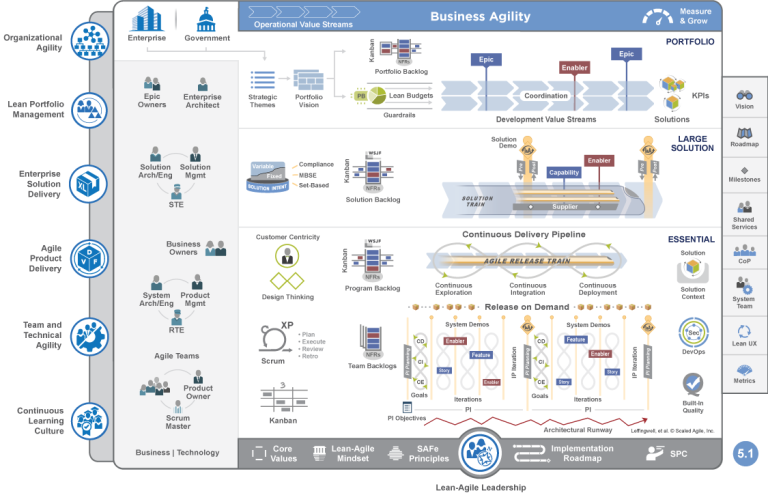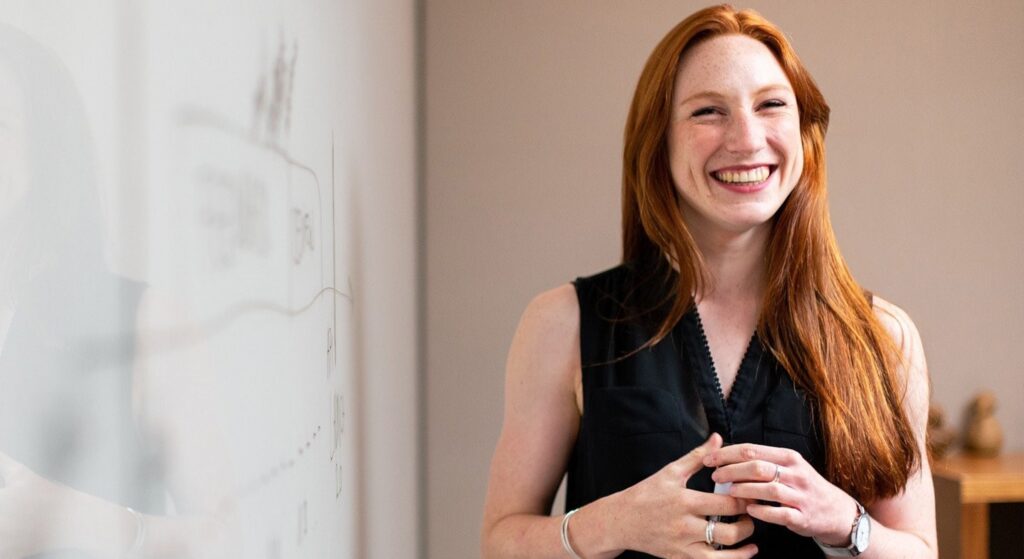SAFe® training courses
The Scaled Agile Framework (SAFe®) is an organisational framework supporting the agile transformation of an entire organisation, and is available as an internationally recognised qualification. Build or deepen your practical knowledge of the SAFe® framework and become a Certified SAFe® Program Consultant with our Certified SAFe® Program Consultant experts!
More information, frequently asked questions about SAFe® and exams
Table of contents
What is Scaled Agile Framework® (SAFe®) 5.1?
SAFe®, the Scalable Agile Framework, is a robust organisational framework that supports the agile transformation of an entire organisation. SAFe® can be built into an "operating system" within an organisation to help maintain a secure agile-based way of working in a changing market environment. The promise of this system is that it makes the creation of complex products and services, even those requiring the collaboration of several teams, traceable, predictable and continuous by introducing rules, events and roles. It makes use of well-established frameworks and approaches that are already well-known parts of agile organisational operations, such as Lean, Scrum, Kanban or DevOps. In addition, by focusing on seven competency areas, SAFe® ensures that the entire organisation, from senior management to team members, has the tools to respond effectively to change and continuously increase productivity.
In what areas can it be used? What are the benefits?
SAFe® is a framework that is built on agile principles, scalable and supports the whole organisation in transformation. Learning SAFe® is not only about learning the framework, but also about the ways in which to implement and sustain changes over time.
The Agile principles and value pairs were originally designed to support the development of software and products, with a focus on more efficient collaboration, iterative workflows and customer centricity. SAFe® is a system where these principles can be extended to multiple teams, departments or even entire organisations.
Organisations often choose an organic way of agile transformation, i.e. they start with a single team to get their first agile experience. However, when the issue of scalability arises, i.e. they want to transfer good practices and experiences to multiple teams, departments, organisational units, they run into obstacles. The coordination, the planning, the rhythm of work, the communication between roles, is easy to understand in a team of 10 people, but difficult to extend to hundreds or thousands of people.
Developing agile operations in a team or department is not enough on its own to improve the performance of the whole organisation. As SAFe® puts it, agile principles must be part of the operating system of the business. Organizations that follow this mindset can respond quickly to change, align their portfolio with customer needs and market changes, and set their priorities accordingly.
The SAFe® system goes beyond the application of agile principles and tools in a team. The framework helps the entire organisation to operate in an agile way, with the necessary receptivity to market changes and innovative demands of the digital age.
Which organisations might be interested in using it?
Worldwide, more than 1,000,000 professionals and 20,000 businesses use SAFe®, regardless of industry. According to Gartner research, SAFe® is the number one framework for implementing scaled agile operations, and is the most sought-after and used framework by organisations.
The approaches and methods currently used are no guarantee that our initiatives will be successful in the future. SAFe® also helps organisations to be more agile and thus more responsive to competitors' moves, users' needs, market changes and opportunities.
How does it differ from/how does it relate to other frameworks?
- SAFe® builds on agile principles and value pairs and also provides specific guidance on the scaling process for large, complex, multi-site organisations or those operating under high regulatory compliance pressure.
- SAFe® takes agile principles and values from the team level to the multi-team or portfolio level, creating more efficient processes and helping to align strategy and execution.
- SAFe® also applies practices and approaches that work in harmony with the agile approach, such as Lean, DevOps, or the systems approach. It does this in order to support the creation of a continuously evolving organisational operation that is able to incorporate lessons learned from new customer requirements, the latest scientific research and modern business practices.

What qualifications can be obtained?
SAFe® offers a range of certifications, with different training covering the knowledge content as follows:
- Certified SAFe® Agilist - Leading SAFe® training
- Certified SAFe® Practitioner - SAFe® for Teams training
- Certified SAFe® Scrum Master - SAFe® Scrum Master training
- Certified SAFe® Product Owner/Product Manager - SAFe® Product Owner/Product Manager training
Are there any prerequisites for the exams?
Yes. Participants must attend every day of the training in order to sit the exam. The first attempt is included in the training fee. The exam can be taken within 30 days of the training.
Can Professional Development Units (PDUs) be credited as part of training?
Yes. A total of 15 PDUs can be credited to those who have completed the training as part of the PMI Project Management Institute's PMP, PgMP, and PMI-ACP certifications. Graduates can earn 12 Technical PDUs, 2.25 Leadership PDUs, and 0.75 Strategic and Business PDUs.
How long can I take the exam for free?
The first test attempt is included in the training fee, provided that the candidate takes the test within 30 days of the training (confirmation of attendance by the trainer). This 30-day period will end at 11:59 p.m. in the time zone of the trainee. In addition, if necessary, the candidate has the possibility to request an extension (Extension policy).
What should I do if I have not taken the exam within 30 days or have failed the exam?
If you do not attempt the exam within 30 days, you can request a further two-week extension free of charge. If you do not attempt the exam within this period, or if you have failed the exam the first time, you can take it again at your own expense. The fee for additional exam attempts may vary from course to course, but in most cases will cost USD 50.
How long is the certification valid?
The qualification obtained by passing the exam is valid for 1 year. To remain valid after this period, you will need to renew your SAFe® Community Platform membership at a fee of USD 295 if you have a certification and wish to renew. In case the participant wishes to extend the membership only, i.e. to access only the platform and the course material, the renewal fee is USD 195.
How can I take the exam? What can I expect in the exam?
The exam is available online on the SAFe® Community Platform, to which all participants will be given access at the start of the training. The training includes a short tutorial to help you navigate the exam site.
A Candidate Agreement must be read and accepted at the start of the exam. There is a time limit for completing the exam, and the timer is displayed in a visible place throughout the exam. When the exam time expires, the exam will be automatically submitted and scored, regardless of the number of questions answered. Unanswered questions are automatically counted as incorrect answers.
The questions multiple choice or multiple response format, which means that questions can have one or more answers and the number of correct answers is determined by the candidate or, where appropriate, the number of options the candidate must select is indicated in the question paper. In this case, marks are awarded only if the candidate has ticked all the correct answers, and no partial marks are awarded for each correct answer. The percentage pass mark varies from course to course.
How do I prepare for the exam?
The training is delivered by a SAFe® Program Consultant certified instructor with practical experience, who will also introduce the exam platform and the preparation material to the trainees. The course material will be provided to participants in digital format and links to free help material will be provided during the training. For each training, the course material consists of specific topics from which the examination questions are drawn. The topics, the corresponding syllabus, the relevance of each topic for the exam questions and the supporting materials are shared with the training participants by the trainer and are available to the participants after the training in case of questions.

























 Designabc
Designabc